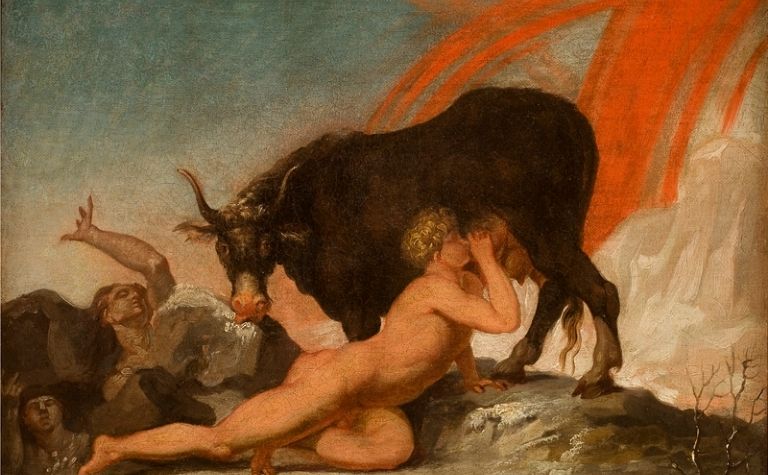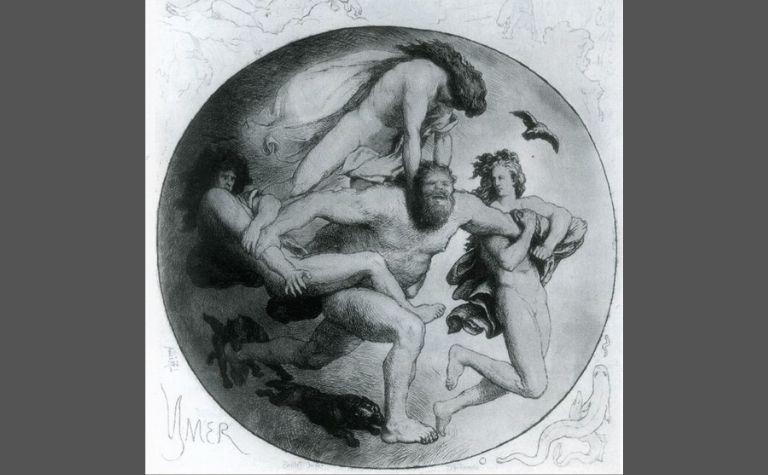Whether or not they enjoy Norse mythology, most people have heard of Thor, Odin, and Loki. Many would probably even recognize names like Heimdallr, Jormungandr, Frey, and Freya.
However, Ymir isn’t nearly as well-known outside of those who enjoy studying Norse mythology.
Ymir, also called Aurgelmir, wasn’t just the first giant in Norse mythology; he was the first being.
Ymir came to life in Ginnungagap, the place between the fiery world of Muspelheim and the icy world of Niflheim.
He was a primordial being and a direct descendant of Odin and the Asgardians.
This article will delve more deeply into Ymir’s story. It will outline why he was so crucial to the Norse myths and his appearance.
Finally, it will summarize Ymir’s narrative and tell the story of how the world was created, at least according to Norse legend.
Also see What Does Valknut Symbol Mean in Norse Mythology? to learn more.

Why Is Ymir Important in Norse Mythology?
Interestingly enough, Ymir means “screamer.” [1] He was the first created being, the first ‘scream into the void.’ But beyond being the first creation, why was he so important?
Ymir is important to Norse mythology because he was the “father” of everything. He was the first primordial being from which all other essential beings – and the world itself – were created.
Without Ymir, there would have been no Asgardian gods, no earth, no seas, and not much else.
During the period when people worshiped the Norse gods, none were more powerful or well-loved than the Aesir.
There was another race of gods, the Vanir, but little is known of them beyond the three that came to Asgard.
Every important story in Norse Paganism includes the Aesir gods. And none of those gods would exist without Ymir.
Technically speaking, Ymir was Odin’s great-grandfather. (This article will discuss the lineage in the section on Ymir’s narrative below.)
Not all Aesir gods are direct descendants of Odin.
However, it’s broadly accepted that they have some common thread of ancestry, even if the myths don’t explicitly outline what that commonality is.
Even Loki, who came to Asgard from Jotunheim, is related to the Asgardians through his Jotun half. (All giants descended from Ymir, and Odin’s mother and Loki’s mother were two of them.)
In short, Ymir was the starting point for everything important that happened in Norse mythology.
Without him, there would be no stories beyond the creation of the outermost of the nine worlds.
Also see Can Ragnarok Be Stopped? to learn more.

What Did Ymir Look Like in Norse Mythology?
Ymir was a huge giant made of frost. Descriptions of him are vague, but the stories refer to him with the pronouns “he and him,” meaning he likely looked like a male in appearance.
However, he was also hermaphroditic and created his offspring asexually within his own body.
Beyond that, little exists about Ymir’s actual appearance, and modern depictions of him vary greatly. [2]
Some images show him typically humanoid, though on a massive scale. In other descriptions, he’s the cold bluish-white of ice, with a beard, eyebrows, and hair made of frost.
Historically speaking, people tend to model their gods after themselves. Statues of the Greek and Roman gods and modern, multi-racial depictions of Jesus Christ are evidence of that.
Although Ymir wasn’t a god in the strictest sense of the word, he was the first being from whom the Aesir gods descended.
With that in mind, he likely looked like what people at the time looked like, only on a much larger scale and possibly blue.
Also see Norse Gods vs Greek Gods: Comparison to learn more.
What Is Ymir’s Narrative in Norse Mythology?
Ymir’s narrative is a creation myth in Norse mythology. It begins with his formation and ends with Odin and his two brothers killing him and using his body to make the world.
In between, he created other giants, who sprung from his legs and the sweat beneath his arms while he slept.
As mentioned above, Ymir formed in Ginnungagap, the empty – some say chaotic – space between the fires of Muspelheim and the icy cold of Niflheim. [3]
Like a tornado, he materialized when the heat met the cold.
The ice began to melt shortly after, revealing a giant cow, Audhumla. Ymir took nourishment from this cow and fell asleep.
The race of giants, or Jotuns, sprang from the sweat of his armpits and his legs.
While this was happening, Audhumla the cow was licking the salty glaciers for nourishment.
After she’d licked for some time, a man named Buri emerged from the ice.
He was the first god of the Aesir and, along with his son Borr, the only two not directly descended from Ymir.
Borr met one of the Ymir’s giant offspring, Bestla, and together, they had three children:
- Odin
- Vili
- Ve
Eventually, the three brothers killed Ymir. Then they used his massive body to create nearly everything in the world, including:
- The sea: Most translations of the Edda say they created the seas from his blood; others say it was from his sweat.
- The earth/land: They made this from his flesh.
- Mountains: These came from his bones.
- Trees/plants/shrubs/etc.: Ymir’s hair became the world’s plant life.
- The sky and clouds: Odin shaped Ymir’s massive skull into the sky and used his brains for clouds.
- Midgard/the Earth: Surprisingly, the entire realm of Midgard came from Ymir’s eyebrows. (Other scholars say they used his eyebrows to build a wall around Midgard.)
- Rocks and stones: These came from his teeth.
- Dwarves: Translations vary on the dwarves. Some say they came from the hills and mountains created with the giant’s bones. Others say they evolved from the maggots that fed on his dead body. [4]
While all this was happening, Ymir’s blood (or sweat in rare translations) flooded the world, creating the seas.
However, it also happened so fast that it swept the giants up with it, drowning all but two of them.
Bergelmir and his wife survived. They escaped the flood, fled to Jotunheim, and were the ancestors of all the giants that came after them.
Conclusion
Ymir was one of the first primordial beings in Norse mythology. He sprung from the chaos of Ginnungagap, and most earthly things came from him.
Also see Norse Gods vs Egyptian Gods: Comparison to learn more.
